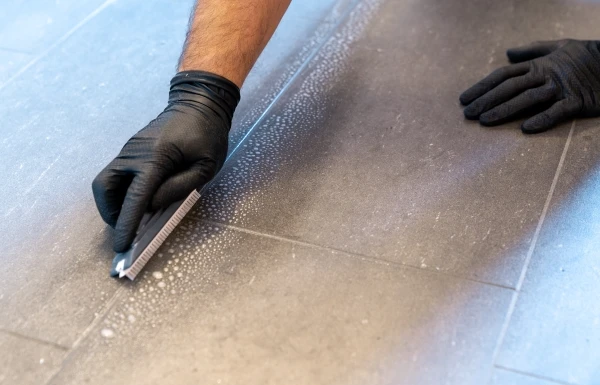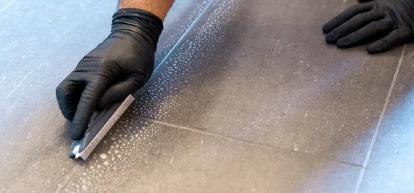
Tile Maintenance Tips and Techniques
When tile isn’t properly maintained and cleaned, it holds bacteria and wears out way too soon. So, whether you already have tile or you’re thinking about installing it, it pays to know how to care for it the right way to prevent future problems.
This guide covers both the basics and the nitty-gritty (or should we say nitty-grouty?) from the perspective of experienced Neighborly home service professionals.
How to Maintain Bathroom Tile:
- Every day, lightly clean bathroom tile. At minimum, keep it free of loose dirt and dust, which can scratch the surface if it isn’t kept in check.
- Every week or two, deep clean the tile using these tips from Molly Maid. Too much work? Reach out to Rainbow International for professional tile cleaning services!
- Every few weeks, inspect the grout, caulk, and tiles for damage. Use the tips below to address any problems you see.
- Always protect tile floors by placing rugs in high-traffic areas and putting felt pads on furniture feet (especially when moving furniture).
- Every six months to two years (depending on wear and tear), reseal your tile and grout. The tile in bathrooms you use every day should be on a six-month reseal maintenance schedule!
- Ensure your bathroom has proper ventilation and an exhaust fan so the tile isn’t constantly exposed to intense heat or humidity.
Tile Maintenance Products to Have Handy
To fully care for your tile, you need the right cleaning products, caulk, sealant, and regrouting tools. The necessary cleaning products are consistent for most types of tile. The other products are a diverse bunch, so you’ll need to choose the right product for the type of tile you have, which we explain more later in this guide.
Important cleaning products:
- For glazed tile: any all-purpose bathroom cleaning spray
- For unglazed tile: A neutra-pH cleaning spray
- Alternatively, a homemade cleaning solution for any tile: a bucket of warm water, a teaspoon of dish soap, a quarter-cup of baking soda, and a cup of white vinegar
- A non-abrasive sponge or cleaning cloth
- A toothbrush for cleaning grout
- A broom (soft-bristled for glazed tile; stiffer for unglazed tile)
Related Topic: Grout vs. Chaulk – What's the Difference?
Three Important Tile and Grout Maintenance Tasks
Let’s talk regrouting, sealing, and fixing loose tiles on walls or floors! If your project is more specialized and you need help from an expert, reach out to Mr. Handyman for tile installation, maintenance, or repair services.
How to Regrout Bathroom Tile
If your grout has cracks in it, it’s time for a refresh. It’s possible to grout over the old grout if the cracks are small enough that a dime wouldn’t fit in them. But you’ll still need to remove the upper surface of the old grout so the new grout can form a strong bond. Large cracks indicate a need for completely regrouting that area.
Here’s how to regrout your tile, whether you’re focusing on a small section or the entire tiled surface:
- Purchase the same type of grout that’s currently between your tiles.
- Remove the old grout with a grout saw. While you work, use a shop vacuum to clean up the debris.
- Apply a diluted bleach solution to the joints you removed grout from. This will eliminate lingering mildew.
- Rinse the tile and joints. Then dry them with a rag but leave the joints a little damp.
- In a small container, mix water into your grout according to the instructions on the packaging.
- Apply the grout to the tile with a rubber-edged grout trowel held at a 45-degree angle. Take a few passes across each section so the grout gets deep into the joints.
- Clean some excess grout off the tile by holding your trowel perpendicular to the surface and scraping across it. The tile will still have some grout on it.
- Wait a few minutes so the grout can begin to set. (Follow product instructions.) Then sweep a soft, damp sponge diagonally across the tile to clean it off further.
- Wait about 10 more minutes before you fully buff the tile with a dry cloth, removing the rest of the grout haze.
- After 48 hours, seal the grout with a grout sealer product by following the manufacturer’s instructions.
As you can see, regrouting is a labor intensive and time-consuming process. Hiring a trusted professional to regrout your tile will not only save you time and labor, it will also ensure the job is done to your complete satisfaction.
How to Fix Loose Tiles in Bathroom
Sometimes the mortar behind a tile (on the floor or the wall) can get knocked loose or become degraded by moisture. If the grout is compromised around that tile too, you’ll have a wiggly tile problem.
Here's how to fix it:
- Purchase grout and mortar compatible with your current tile.
- Using a grout saw, remove the old grout around the single tile.
- With a light hammer, tap a masonry chisel against the base of the tile’s loosest edge until the chisel works its way slightly underneath. Work the chisel around the tile like this until it’s freed.
- Use the hammer and chisel to remove the old mortar behind the tile you removed and on the back of the tile itself.
- Apply a layer of fresh mortar according to the instructions on your mortar packaging, and press the tile onto it, centered on the gap.
- Wait at least 12 hours (or the manufacturer-recommended duration) before regrouting the spaces around the tile.
Once again, fixing loose tile can get a little tricky, especially if you don’t have all the right tools and/or patience to do a thorough job. Hiring a trusted pro could save you the aggravation of having to repeat the process a few months later.
How to Seal Bathroom Tile
Many types of tile need to be sealed, and all grout does. This makes the surface resistant to wear and the buildup of dirt. Glossy ceramic and porcelain tile surfaces often don’t require a sealer. In any case, the tile manufacturer will specify the best way to preserve the tile.
If your tile is sealed, it will need to be resealed up to two times a year. Surface/topical sealers need to be reapplied more often than penetrating and solvent-based sealers. The instructions below link to more details about types of sealers.
Here's the process for sealing tile:
- Select a penetrating (solvent-based or water-based) or surface/topical sealer, depending on the tile you’re finishing. If the sealer product doesn’t come with an applicator tool or sponge, purchase the recommended type.
- Clean the tile very well with all-purpose cleaner, rinse it with clean water, dry it with a towel, and wait at least six hours so excess moisture evaporates.
- Open windows and put on a respirator mask and gloves to protect yourself from the chemicals in the sealer.
- Follow instructions for your sealer. The process will likely involve spraying or spreading the product over the tiled surface, waiting a few minutes, and wiping off the excess.
Related Topic: How to Grout a Tile Backsplash Like a Pro
Thinking of Upgrading Your Tile or Adding More?
Upgrading your tile—whether it's in a trendy new shower enclosure or your kitchen—can completely change the look of a room. We mean that in a good way! So if your current tile is in poor condition, it might make sense to replace it instead of making a repair. Additionally, replacing carpet with tile in other parts of your home is an excellent way to reduce indoor allergens.
We’ve already let you know that Mr. Handyman is an awesome go-to tile expert, but what if you’re doing a bigger room renovation and need other support? You can count on the rest of the Neighborly family of experienced home service pros for practically any project. Search for available local services to get started.



 Back
Back
 1 (855) 217-8437
1 (855) 217-8437


